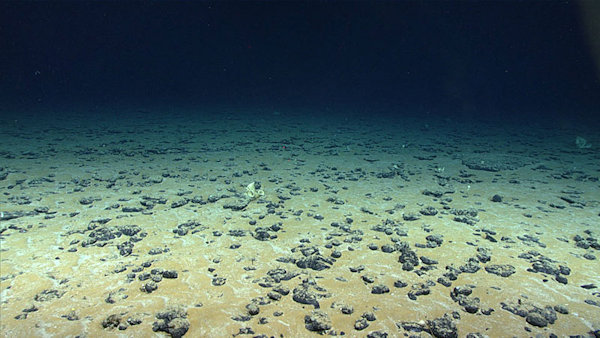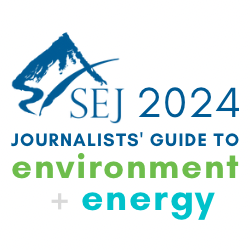SEJournal Online is the digital news magazine of the Society of Environmental Journalists. Learn more about SEJournal Online, including submission, subscription and advertising information.
 |
 |
| Phosphorite nodules on the ocean floor, seen during an exploration dive to search for signs of disturbance near an area subject to experimental deep-sea mining technologies. Photo: National Oceanic and Atmospheric Administration. |
TipSheet: Seabed Mining May Dredge Up Real Minerals, Fishy Worries in 2024
By Joseph A. Davis
 |
The nations of the world are on the brink of starting a large enterprise of mining metals and minerals by bringing up nodules lying on the bottom of the world’s ocean.
The United Nations body in charge, the International Seabed Authority, has been trying — and failing — to agree on rules for seabed mining. Meanwhile, some companies and countries are itching to jump the gun.
It’s a tough conundrum, with the truth often concealed in the dark depths of the open ocean.
So expect the year 2024 to see continued controversy about seabed mining, a struggle that will challenge environmental journalists to dissect conservation concerns and assay possibly phony claims.
Why it matters
There’s a lot at stake in the seabed mining issue … and a lot of parties with a potential stake.
First, there is ocean conservation. The ocean, which covers 71% of the Earth’s surface, is an incredibly valuable resource, in too many ways to completely describe here.
To humans, it provides food, transportation, energy, recreation and wonder. It also provides food: some 200 billion pounds of fish and shellfish annually.
As a carbon sink and heat reservoir, it ameliorates and postpones climate heating.
Unfortunately, human threats to the ocean, such as pollution and overfishing, are many.
At the same time, the ocean is still very much a mystery, only a fraction of which has been explored.
The backstory
We are not going back to the Code of Hammurabi, which recorded the earliest known law of the sea back around 1780 B.C.
In actuality, the open seas have been an often lawless place during many of the years since. Think pirates. Well, actually it’s more complicated than that, as ocean law evolved haltingly over the millennia from a jumble of customs, treaties and agreements.
But starting in the 1950s, nations struggled to find consensus on something more. Under U.N. auspices, they finally came up with the U.N. Convention on the Law of the Sea in 1982. It took effect in 1994. Today, some 168 states have ratified it. The United States, however, has not.
One of many things the convention does is to define which waters are subject to national sovereignty — particularly the Exclusive Economic Zone, which usually extends 200 miles from a nation’s shore. Each nation has exclusive rights to things like fisheries and minerals within its EEZ.
But beyond the EEZ, rules are set by the International Seabed Authority … which so far has not been able to agree on final rules.
Nations had been trying to set
seabed mining rules for decades,
but then a tiny Pacific island nation
announced it intended to start mining.
Nations had been trying to set seabed mining rules for decades, but in summer 2021 the tiny Pacific island nation of Nauru announced that it intended to start mining. That triggered a two-year clock requiring final rules. Negotiations intensified. Over 20 nations eventually formed a coalition calling for the suspension of seabed mining altogether.
Nations in the seabed authority met during July 2023 in an effort to agree on final rules — but couldn’t. The deadline was left unmet and the agency gave itself another year.
Meanwhile, limited seabed mining is going on under special permits in a “test” regime. A lot of this activity is focused on the Clarion-Clipperton Zone, a formation thousands of miles long in the mid-Pacific. In one 2016 exploration of that zone’s seafloor, about half of the species found were previously unknown to science.
The usual arguments
You will often hear people say (and news stories suggest) that the minerals potentially available from seabed mining are crucial to the transition to clean energy that won’t worsen climate heating.
Let’s face it, that has become a journalistic cliche. While it has some validity, it is worth examining skeptically.
Green energy fans like to talk about finding enough lithium to make the batteries needed for the energy transition (whether for cars, homes or utilities). But there is very little lithium down on the seabed, and a lot more of it in purer forms up here on land.
Typically, the main minerals to be found on the seabed are manganese, nickel, copper and cobalt. They are found in “polymetallic nodules,” hand-sized rocks, littered across some areas. There is also iron oxide, as well as trace amounts of molybdenum and tellurium.
Today, the world gets most of its iron, copper and nickel elsewhere (albeit not always in environmentally friendly or human-friendly ways). There isn’t really a shortage of those minerals on the surface. But they will be needed to make electric vehicles and other electrical technology. Potentially, the amount of these minerals on the seafloor is enormous.
Conservationists and some fishing groups
fear the destruction of important deepsea
habitats. … A lot depends on mining methods.
Conservationists and some fishing groups fear the destruction of important deepsea habitats. It can be a knee-jerk attitude, especially in the absence of precise information. Seafloor environments vary widely.
A lot depends, of course, on the mining methods. These vary with depth. Sometimes the minerals are just vacuumed up. Sometimes deepsea robots are used to grab the minerals. Sometimes there is excavation of sediment or cutting of rock. Some methods stir up and mobilize sediments, which move on to damage marine life in a wider area.
The International Seabed Authority plans to meet again starting in 2024. Prospects for agreement on a political solution to the mining controversies are still unclear.
Questions to ask
- What is known about each area proposed for seabed mining? Where is it? How big is it in area? What is its depth?
- What physical form are the minerals in? What minerals are expected to be found?
- What method(s) will be used to collect the seabed minerals? What will those methods disturb?
- How much sediment will the collection methods generate?
- What measures are planned to ameliorate any potential damage to the seafloor or marine ecosystems?
- What economic and political forces guide each nation’s position on the seabed mining issue?
Reporting resources
- International Seabed Authority: Set up under the Law of the Sea Treaty, the authority’s mandate is to regulate seabed mining.
- Oceana: A nonprofit nongovernmental advocacy group that works on many kinds of ocean conservation.
- Ocean Conservancy: A membership advocacy group with an emphasis on coastal cleanup.
- The Metals Company: A private firm already doing seabed mining on a test basis.
- Deep Sea Conservation Coalition: An international grouping of NGOs opposed to both deepsea mining and to seabed trawling for fish.
- The Ocean Foundation: An international NGO devoted to conservation. It builds coalitions and works as a think tank.
Joseph A. Davis is a freelance writer/editor in Washington, D.C. who has been writing about the environment since 1976. He writes SEJournal Online's TipSheet, Reporter's Toolbox and Issue Backgrounder, and curates SEJ's weekday news headlines service EJToday and @EJTodayNews. Davis also directs SEJ's Freedom of Information Project and writes the WatchDog opinion column.
* From the weekly news magazine SEJournal Online, Vol. 8, No. 40. Content from each new issue of SEJournal Online is available to the public via the SEJournal Online main page. Subscribe to the e-newsletter here. And see past issues of the SEJournal archived here.












 Advertisement
Advertisement 



